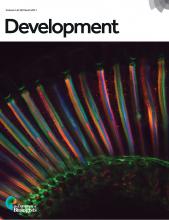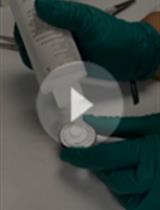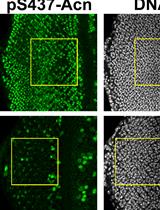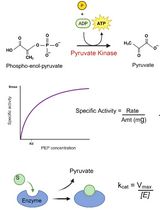- EN - English
- CN - 中文
Protease Activity Assay in Fly Intestines
苍蝇肠道蛋白酶活性测定
发布: 2017年09月20日第7卷第18期 DOI: 10.21769/BioProtoc.2560 浏览次数: 9533
评审: Jihyun KimTzvetina BrumbarovaAnonymous reviewer(s)
Abstract
The intestine is a central organ required for the digestion of food, the absorption of nutrients and for fighting against aggressors ingested along with the food. Impairment of gut physiology following mucosal damages impacts its digestive capacities that consequently will affect growth, wellbeing or even survival of the individual. Hence, the assessment of intestinal functions encompasses, among others, the monitoring of its integrity, its cellular renewing, its immune defenses, the production of enteroendocrine hormones and its digestive capacities. Here, we describe in detail how to assess the activity of the proteases secreted in the intestinal lumen of adult Drosophila melanogaster flies. This method can also be used for larval intestines. The present protocol is adapted and improved from the Sigma-Aldrich’s protocol proposed in the ‘Protease Fluorescent Detection Kit’ (Product code PF0100).
Keywords: Drosophila melanogaster (黑腹果蝇)Background
The intestine is subjected to many stresses such as feasting, fasting, chemicals, pathogens, injuries etc. The gut is able to overcome such stresses by maintaining its physiological equilibrium named homeostasis. To perceive the incoming stress and to yield an adapted answer to maintain gut functions, the intestine has developed robust and conserved mechanisms such as local innate immune defenses and tissue regeneration (Royet and Charroux, 2013; Bonfini et al., 2016). However, the maintenance of gut homeostasis can be compromised in certain cases. For example, during aging, there is an overall decline in tissue homeostasis maintenance with the presence of numerous immature or misdifferentiated cells (Jasper, 2015; Hu and Jasper, 2017). Another case where homeostasis can also be disrupted is upon exposure to xenobiotic or pathogens (such as opportunistic bacteria) that damage or kill cells impairing their functions (Bonfini et al., 2016). Hence, during the above cited examples, the digestive capacities of the gut are reduced. Moreover, during the process of tissue regeneration itself that produces many precursor cells the digestive capacities are also reduced (Loudhaief et al., 2017). Therefore, the assessment of the digestive capacities of the gut are of prime importance to evaluate the potential impact that can have an aggression on the gut physiology. Importantly, gut digestive function disruption may have both local and systemic metabolic consequences that will affect growth, immune defenses, reproduction, wellbeing, longevity…. Dietary proteins are essential for many (if not all) physiological functions (Soultoukis and Partridge, 2016). Imbalanced amino-acid absorption by the intestine can have dramatic consequences on growth for example. Protein digestion being essential to generate absorbable amino-acids by the enterocytes, the measurement of luminal protease activity appears a good readout to evaluate the physiological state of the intestine and its capacity to fulfill its digestive functions.
Materials and Reagents
- Drosophila rearing
- 6oz Drosophila stock bottles (Genesee Scientific, catalog number: 32-130 )
- Cotton balls for stock bottles (Genesee Scientific, catalog number: 51-102B )
- CantonS flies (Bloomington Drosophila Stock Center, catalog number: 64349 ) (flystocks.bio.indiana.edu)
- Agar (VWR, BDH®, catalog number: 20768-361 )
- Sugar (Carrefour or any other supermarket)
- Cornflour (AB, Celnat - NaturDis)
- Yeast (Biospringer, catalog number: BA10/0-PW )
- Tegosept (Apex, Fly Food preservative, Genesee Scientific, catalog number: 20-258 )
- Standard nutrient medium for Drosophila (see Recipes)
- 6oz Drosophila stock bottles (Genesee Scientific, catalog number: 32-130 )
- Bacterial culture
- Petri dishes
- Sterile tip
- 15 ml tubes (Corning, Falcon®, catalog number: 352096 )
- Graduated test tube
- Bacillus thuringiensis var. kurstaki (Btk) strain identified under the code 4D22 at the Bacillus Genetic Stock Center (http://www.bgsc.org/) and described by (Gonzalez et al., 1982)
- Erwinia carotovora carotovora (Ecc) was kindly provided by Bruno Lemaitre’s laboratory (École Polytechnique Fédérale, Lausanne, Switzerland)
- Escherichia coli (Ec) (One ShotTM TOP10 Chemically Competent E. coli) (Thermo Fisher Scientific, InvitrogenTM, catalog number: C404003 )
- Luria broth powder (Conda, catalog number: 1551 )
- Agar bacteriological (Euromedex, catalog number: 1330 )
- LB medium (see Recipes)
- LB-agar medium (see Recipes)
- Intoxication
- Cotton balls for narrow vials 25 mm (Genesee Scientific, catalog number: 51-101 )
- Spectrophotometry cuvettes (Ratiolab, catalog number: 2712120 )
- 2 ml microtubes (Paul Bottger, catalog number: 02-043 )
- 20 mm filter disks (Chromatography paper 3MM Chr) (GE Healthcare, catalog number: 3030-917 )
- 50 ml tube
- Drosophila narrow vials 25 mm (Genesee Scientific, catalog number: 32-109RL )
- Sucrose (Euromedex, catalog number: 200-301-B )
- 10% sucrose (see Recipes)
- Dissection
- 1.5 ml microtubes (Paul Bottger, catalog number: 02-063 )
- Graduated test tube
- Watch glass (Steriplan Petri dishes, DWK Life Sciences, catalog number: 237554008 )
- Ice
- Ethanol 70% (VWR, catalog number: 83801.360 )
- 10x PBS (Euromedex, catalog number: ET330 )
- 1x phosphate-buffered saline (PBS) (see Recipes)
- 1.5 ml microtubes (Paul Bottger, catalog number: 02-063 )
- Sample preparation
- Microtube pestle 1.5 ml (Argos Technologies, catalog number: P7339-901 )
- 0.5 ml microtubes (Paul Bottger, catalog number: 02-053 )
- 1x phosphate-buffered saline (PBS) (see Recipes)
- Assay
- 1.5 ml microtubes (Paul Bottger, catalog number: 02-063 )
- 96-well black microplates (Greiner Bio One International, catalog number: 655076 )
- 2 ml microtube
- 15 ml tube
- Aluminum foil
- Trypsin from bovine pancreas (Sigma-Aldrich, catalog number: T1005 )
- 1 mM HCl
- Casein Fluorescein IsoThioCyanate from bovine milk (Sigma-Aldrich, catalog number: C0528 )
- Distilled water
- cOmplete tablets EDTA-free (Roche Diagnostics, catalog number: 04693132001 )
- Trichloroacetic acid (TCA) (Sigma-Aldrich, catalog number: T6399 )
- Tris base
- Trypsin solution (see Recipes)
- Casein-FITC (see Recipes)
- 25x cOmplete (see Recipes)
- 10% TCA (see Recipes)
- 0.5 M Tris/HCl pH 8.5 (see Recipes)
Equipment
- Drosophila rearing
Refrigerated oven at constant temperature of 25 °C and with a 12 h/12 h light/dark cycle (Fisher Scientific, catalog number: 11857552). Humidity has to be maintained between 40% and 70%
Manufacturer: LMS, model: Model 240 . - Bacterial culture
- 100 ml flasks (Fisher Scientific, catalog number: 15409103 )
- 30 °C/37 °C shaking incubator (Infors, model: AK 82 )
- Intoxication
- Spectrophotometer (Aqualabo, Secomam, model: Prim Light & Aduanced)
- Droso-sleeper (Inject-Matic)
- Dissection
- Stereomicroscope (Leica Microsystems, model: Leica M60 )
- Dumont forceps #5 (Fine Science Tools, catalog numbers: 11251-20 and 11252-20 )
- Sample preparation
- Pestle motor (Heidolph Instruments, model: RZR 2100 )
- Refrigerated microfuge (Eppendorf, model: 5430 R )
- Assay
- Vortex (Scientific Industries, model: Vortex-Genie 2 )
- Automated pipette (Eppendorf, model: Multipette® plus)
- 37 °C solid-door incubator (Jouan)
- Fluorimeter (Agilent Technologies, model: Cary Eclipse )
Software
- Kyplot
- Excel
Procedure
文章信息
版权信息
© 2017 The Authors; exclusive licensee Bio-protocol LLC.
如何引用
Nawrot-Esposito, M., Loudhaief, R. and Gallet, A. (2017). Protease Activity Assay in Fly Intestines. Bio-protocol 7(18): e2560. DOI: 10.21769/BioProtoc.2560.
分类
生物化学 > 蛋白质 > 活性
您对这篇实验方法有问题吗?
在此处发布您的问题,我们将邀请本文作者来回答。同时,我们会将您的问题发布到Bio-protocol Exchange,以便寻求社区成员的帮助。
Share
Bluesky
X
Copy link













